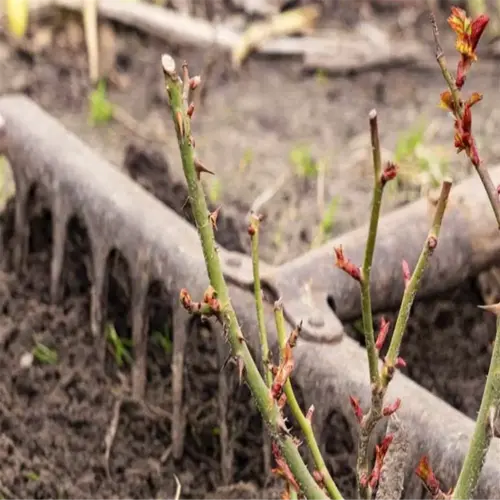How to Grow Bananas: Expert Tips for Bountiful Harvests

Written by
Julia Anderson
Reviewed by
Prof. Martin Thorne, Ph.D.Growing bananas: Choose dwarf varieties for dry or non-tropical climates
Adjust your soil pH between 5.5-7.0 with compost to maximize nutrient uptake
Water 1-2 inches each week, using drip irrigation to keep roots from staying wet
Fertilize monthly with 8-10-8 fertilizer during the active growing seasons
Harvest when the ribs of the bananas are visible and the flower tips easily detach
Use neem oil sprays and marigolds to help mitigate pests.
Article Navigation
If you have ever questioned about how to grow a banana tree then you will find that growing bananas is easier than most people realize. These tropical giants provide three sources of value, beauty, fruit, and wind protection. My first banana plant helped change an ordinary plain corner of the backyard into a place of lush beauty and protected my tender vegetables from the wind.
Bananas take some patience. It may take anywhere from 9 to 18 months until the first harvest. This time, however, is not wasted. The ornamental giant foliage of banana trees provides immediate drama to the space. I have installed banana trees as living screens in my courtyard, hiding compost bins, or AC units, for example. The banana tree becomes so much more than growing food; it becomes edible landscaping.
I will always remember the look of disbelief on my neighbor's face when container-grown Dwarf Cavendish bananas were growing abundantly on my patio in a heavily shaded location, demonstrating that the old myths about acreage have ceased to be valid! Yes, these plants can be grown in urban settings, provided you replicate their preferred humidity and warmth.
Choosing the Right Banana Variety
Successful banana plant cultivation begins with variety selection. The versatile Dwarf Cavendish, for example, will grow well in pots and has some cold tolerance, while the towering Lady Finger wants a tropical environment. Recently, my neighbor's Lady Finger collapsed under 15 feet of snow due to chilling temperatures in Florida, proving that the size of the plant matters when dealing with cold tolerance. The key here is to use the breeding strength of species to adapt to your USDA (United States Department of Agriculture) zone.
Lady Finger bananas have their *champagne* reputation because of their elongated, sweet nature, but they are *divas* in the garden; they require steady 80-degree days, and staking that can withstand a hurricane. My patio Red Banana, with its beautiful maroon and striped leaves, offers the same drama when we have a night that dips to 45 degrees, which would typically kill half of the dessert varieties.
New growers frequently miss ornamental bananas. The red banana I planted below my bedroom window exceeded the hibiscus blooms as well as producing edible fruit. Use them with elephant ears for added tropical texture. Just remember the purple showstoppers on the backside of the leaves turn to green with full sun, but partial shade holds the color.
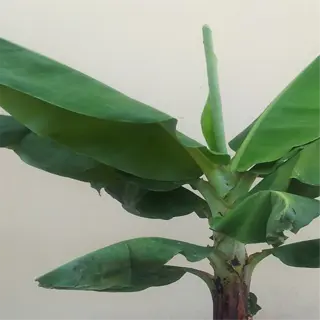
Dwarf Cavendish
- Container-ready: Fits in 25-gallon pots with proper drainage
- Cold sensitivity: Requires protection below 50°F (10°C)
- Fruit quality: Sweet 6-inch bananas ideal for fresh eating
- Growth speed: Produces fruit in 12-15 months from planting
- Space needs: 4 ft (1.2 m) spacing between plants minimum
- Special care: Needs weekly fertilization during warm seasons

Blue Java
- Temperature resilience: Tolerates brief dips to 28°F (-2°C)
- Unique texture: Creamy flesh resembles vanilla ice cream
- Maturation time: 18-24 months to first harvest
- Wind resistance: Sturdy pseudostems withstand 35 mph gusts
- Pest resistance: Naturally repels common banana aphids
- Water needs: 2 inches (5 cm) weekly via drip irrigation
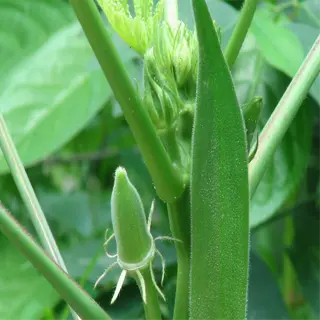
Lady Finger
- Flavor profile: Honey-like sweetness with floral undertones
- Sun requirements: 8+ hours of direct sunlight daily
- Pest vulnerability: Susceptible to banana weevils in humid climates
- Harvest window: 15-18 months from planting to first yield
- Soil preference: Loamy soil with 6.0-7.0 pH
- Wind tolerance: Requires staking in areas with 20+ mph winds
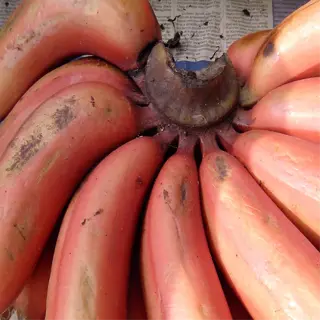
Red Banana
- Aesthetic appeal: Maroon-purple skin with pink-tinged flesh
- Cold limits: Damaged below 40°F (4.4°C)
- Yield consistency: Produces 2-3 bunches annually in tropics
- Flavor notes: Raspberry-like tang complements sweetness
- Fertilizer needs: High magnesium (1 lb/plant every 3 months)
- Spacing: 8 ft (2.4 m) between plants for airflow
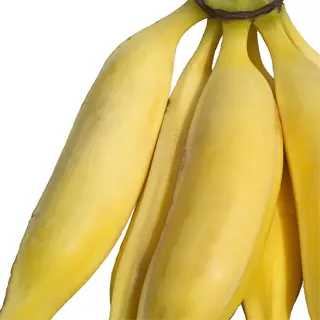
Plantains
- Culinary use: Requires cooking for optimal flavor and texture
- Drought tolerance: Survives 2-week dry spells once established
- Growth habit: Spreads 10-12 ft (3-3.6 m) laterally at maturity
- Disease risks: Prone to black sigatoka fungus in wet seasons
- Storage: Green fruit lasts 4 weeks at 55°F (13°C)
- Nutrition: Higher starch content than dessert bananas
Ideal Climate and Soil Setup
Bananas require warmth, but they can adapt themselves nicely to subtropical zones when you value the plant roots above air temperature. I confused soil temperatures when I took a temperature gauge with me through different zones--roots are stagnant below 60°F. The bananas I planted in Texas were successful because I used black plastic mulch that trapped heat like the forest floor of a tropical region. For your soils- they should drain quickly and feel like the morning dew of Florida's sandy loam.
The soil pH differentiates success for growing bananas. Soils originating from tropical volcanic landscapes tend to be more acidic (5.5 - 6.5) while Mediterranean clays are alkaline. I was able to save a very stressed Red Banana by adding a bit of pine fines into my clay that was at 7.2 pH. I test my soil every year and then make adjustments with sulfur or lime based on those results. These adjustments will take six weeks to activate.
Composted manure is the ultimate enhancer of fruit sweetness. My Dwarf Cavendish in Arizona produced relatively flavorless bananas until I applied a 4-inch layer of well-rotted chicken manure. The subsequent crop of bananas dripped with honey-like sweetness. Matter that is rich in organic content nourishes microorganisms, which, in turn, convert potassium into sugar and other carbohydrates, contributing to fruit sweetness.
Temperature Requirements
- Daytime ideal: 80-90°F (27-32°C) for Cavendish varieties
- Nighttime minimum: 60°F (16°C) to prevent growth stunting
- Root zone: 70-80°F (21-27°C) for optimal nutrient uptake
- Cold protection: Mulch 12 inches (30 cm) deep below 50°F (10°C)
Soil Composition
- Sand content: 40% for drainage + 40% silt for moisture
- Clay limit: ≤20% to prevent waterlogging
- Volcanic ash: Ideal for magnesium/phosphorus supply
- Cation exchange: 15-25 meq/100g for nutrient retention
pH Balancing
- Acidic soils: Add dolomite lime (5 lbs/100 sq ft)
- Alkaline soils: Mix peat moss (30% volume)
- Testing frequency: Every 45 days during growth spurts
- Container plants: Maintain 5.8-6.2 for dwarf varieties
Drainage Solutions
- Raised beds: 18 inches (45 cm) minimum height
- French drains: Install 3 ft (0.9 m) deep trenches
- Perlite mix: 25% ratio in heavy clay soils
- Slope gradient: 2% minimum for field plantations
Organic Matter
- Compost: 2-3 inch (5-7.5 cm) annual layer
- Manure: Aged chicken (4-6 months) preferred
- Biochar: 10% mix increases water retention 30%
- Leaf mold: Best for magnesium-deficient soils
Planting and Watering Basics
The difference between suckers and rhizomes is planting depth. For suckers, the roots are usually shallow, so planting them deep, in my experience, is best at around 12 inches. A rhizome chunk, on the other hand, only needs 2 inches of soil, since a rhizome has energy reserves to push it out of the soil to grow. My first rhizome attempt failed by planting them too deep like a sucker. You can avoid that mistake.
Sandy soils should be watered twice a week. Clay soils could rot the roots of your plants if watered more than once a week. I flooded a Cavendish in my garden in Arizona that had clay soil until I added perlite to the soil. The best method to check if the soil is moist is to press two fingers into the soil and see if moisture is present at the depth of your knuckles.
Banana roots cannot survive if the soil is dense and does not allow for air pockets to develop in the soil. I now line my planting holes with coconut coir after losing plants due to the soil. I observed a neighbor had a fantastic banana grove, and noted they were planting in raised beds with about 30% gravel. This showed me that good drainage is more important than fertilizer for the initial establishment of the plants.
Soil Preparation
- Drainage test: Dig 12-inch (30 cm) hole & fill with water
- Organic matter: 4-inch (10 cm) compost layer pre-planting
- pH adjustment: Apply lime/sulfur 6 weeks before planting
- Slope requirement: 2% minimum grade for runoff
Watering Schedule
- New plants: Daily 1-gallon (3.8-liter) drinks first 2 weeks
- Established plants: 2 inches (5 cm) weekly via drip system
- Heat waves: Add 50% more water at dawn/dusk
- Rainy seasons: Reduce irrigation to prevent rot
Mulching
- Material: 6-inch (15 cm) straw/wood chip layer
- Replenish: Every 8 weeks during growing season
- Root protection: Keep 4 inches (10 cm) from pseudostem
- Weed control: Replace moldy mulch immediately
Drainage Checks
- Puddle test: No standing water after 1 hour
- Root inspection: White tips = healthy; brown = waterlogged
- French drains: Install where water pools >30 minutes
- Container plants: 1 drainage hole per 5 gallons (19 liters)
Special Cases
- Sandy soil: Water 2x daily in 90°F+ (32°C+) weather
- Clay soil: Limit to 1 inch (2.5 cm) every 3 days
- Sloped terrain: Use drip tape on contour lines
- Windy areas: Add 25% more water to offset evaporation
Fertilizing and Maintenance
Balanced fertilization can be the difference between islands of sustaining banana trees and struggling plants. Organic material represents the slow release of nutrients, like composted manure. It releases nutrients slowly which can be beneficial for basic growth processes. Grows synthetic blends like 8-10-8 blends will provide an instant benefit like the boost of potassium during flowering. A mentor from Costa Rica would use both in alternating periods - manure when rains were consistent and granules during droughts.
Match the growing stage with nutrients. Young plants are hungry for nitrogen to support leaf growth and expansion. An actively fruiting plant will need extra potassium. I almost lost a harvest by ignoring this and leaves that turned yellow were a cry for magnesium. A foliar spray of Epsom salts cleared that up in three days. Best practice: test soil before blooming season.
Magnesium deficiencies appear as yellow stripes running between leaf veins. Mix 2 tablespoons of Epsom salts per gallon, and apply every week until the plant recovers. My Red Banana recovered more quickly with foliar sprays (spraying on the deficiency) than with drenches to the soil (pouring it onto the ground). Foliar feeding is often a great option for magnesium feeding when the soil is not absorbing well, which can be common in clay-heavy gardens.
The foliar feed has a faster reaction time than root uptake. During a heat wave, the edges of my plants' leaves browned. I gave them a kelp emulsion mist at dawn and within 48 hours they perked right up and greened up. Spray the undersides of the leaves because that is where the stomata are located and absorb the nutrients best. Don't spray it in the middle of the day or it may burn the leaves.
Nutrient Schedule
- Growth phase (0-6mo): Focus on nitrogen for leaf development
- Flowering phase: Increase potassium for fruit formation
- Fruiting phase: Maintain balanced 8-10-8 NPK
- Dormancy phase: Reduce feeding by 50%
Pest Control
- Aphids: Spray neem oil every 10 days
- Weevils: Apply diatomaceous earth around base
- Nematodes: Marigold companion planting
- Mites: Increase humidity to 75%+
Pruning Protocol
- Dead leaves: Remove weekly with sterilized shears
- Suckers: Keep 2-3 healthy pups per plant
- Flower stalk: Cut 15cm below last hand
- Post-harvest: Leave 30cm stub for nutrient recycling
Soil Testing
- pH checks: Every 60 days using probe
- Nitrogen levels: Leaf color indicates deficiency
- Potassium test: Purple leaf edges signal need
- Magnesium: Yellow stripes require Epsom salts
Seasonal Adjustments
- Summer: Increase watering with fertilizer
- Monsoon: Add silica for root strength
- Winter: Top-dress with warm compost
- Spring: Double micronutrient supplements
Harvesting and Ripening
The visual signs of ripeness are angles along the banana, where the edges are rounded, and if they are sharp, this lets me know I need to wait longer. I harvested a banana once too early, thinking that size equaled maturity. The fruit was so filled with starch that it never matured to any sort of sweetness. If you rub the tip, you should note that the remnants of the flower should rub right off.
Temperature affects what is known as ethylene gas, the compound that triggers ripening. I brought some in a bunch to ripen in my garage and noticed that in about thirty-six hours, the bananas had ripened twice as fast as the ones I stored in the fridge at 36°F. Just ensure they are above 57°F for ethylene production. My neighbor claims that if you place an apple nearby, the ethylene from the apple will speed up the yellowness of the banana skin color.
Severing methods are the most effective way to stop sap stains from blackening the skin. Using a curved knife, angled downward, make a cut 15 inches above the top hand of the stalk while applying downward pressure with your non-cutting hand. I know this first hand; sap from horizontal cuts ruined three shirts I wore during my harvest. Wipe the blade with synthetic vinegar after each cut.
Shelf life is contingent on the relative humidity. Source undissociated towels in crates or store at 85-90% RH. After the first harvest, they wilted in the dry air until I started using a reptile fogger in addition to the towels in the same crate (damp towels). Commercial growers utilize plastic perforated bags as they hold moisture without suffocating the fruit.
Cutting Techniques
- Tool selection: Use curved stainless steel knives to prevent sap oxidization
- Stalk angle: Cut 12-15 inches above highest hand at 45° angle
- Sap management: Wipe blades with vinegar-water solution between cuts
- Bunch support: Prop stalk with Y-shaped pole before cutting
Storage Conditions
- Temperature: Maintain 56-58°F (13-14°C) for 3-week storage
- Humidity: 85-95% RH to prevent peel splitting
- Ventilation: 1 air change per hour in storage rooms
- Ethylene control: <0.1 ppm for delayed ripening
Ripening Acceleration
- Ethylene gas: 100-150 ppm for 24-48 hours at 62-68°F (17-20°C)
- Temperature boost: Increase to 70°F (21°C) after gassing
- Fruit pairing: Add apples (1:20 ratio) for natural ethylene
- Color monitoring: Check hourly after Brix reaches 24°Bx
Quality Checks
- Finger pressure: 2-3 psi ideal for transport-ready bananas
- Peel integrity: Reject bunches with >3 latex ooze points
- Stem seal: Dip in 2% citric acid to prevent crown rot
- Weight loss: Limit to 5% during 30-day storage
Consumer Ripening
- Counter method: 68-72°F (20-22°C) with paper bag cover
- Stem wrap: Foil cover on cut stem slows over-ripening
- Refrigeration: Only after reaching desired yellow color
- Freezing: Peel and dip in lemon juice before storage
5 Common Myths
Bananas need the constant heat of the tropics in order to survive and fruit.
Bananas grow best at 78-86 degrees F; dwarf varieties such as Dwarf Cavendish can tolerate 50 degrees F (10 degrees C) with protection. Adequate mulching, mulched bedding practices, and proper windbreaks can allow bananas to grow in USDA zones 8-11. Frost-free microclimates open the doors to being able to grow non-tropical bananas.
All banana plants produce edible fruit you can eat raw.
Many ornamental varieties like Musa velutina produce inedible seedy fruit. Cooking bananas (plantains) must be heat-processed. Only dessert types like Cavendish/Lady Finger are palatable raw. Verify edibility before planting.
Bananas require daily watering to ensure leaf retention
All bananas need 1-2 inches (2.5-5 cm) of water a week, however, if you water too much, you will cause root rot to set in. Plants that have been established can handle a 7-day dry spell. To check if your plant needs water, use the finger test: If moist 2 inches (5 cm) down is optimal.
After harvesting, banana plants die completely.
The pseudostem of the banana plant (the original) dies after it fruits, but the rhizome will put out new suckers (new plants). As a best practice, maintain 1-2 pups from any given plant in order to have crops that are always at peak performance. When you divide corms in the future, 5-7 years will be possible from the original planting.
Homegrown bananas taste the same as cultivated bananas.
Tree-ripened homegrown bananas can develop 30% more sugars than commercial fruit picked green. But thin-skinned heirloom cultivars bruise really easy, unlike the thick-skinned Cavendish. The flavor of bananas varies, as in Red Bananas with berry notes.
Conclusion
It can be simpler than many would believe to learn how to grow bananas. My first experience growing a pup from the supermarket, in a patio pot, produced fruit within 14 months... and I have no PhD. The best banana type to grow is the Dwarf Cavendish, as it is one of the most forgiving varieties. If a beginner makes some errors overwatering their plant, not watering enough, or even feeding their plant erratically, we would still have a successful crop.
Don't let climate uncertainty deter you! I have grown bananas in Ohio winters with just grow lights and plastic tubs that act as mini-greenhouses. Container varieties adjust to your lifestyle; therefore, consider swapping out ornamental palms for edible banana plants that will do well in 25-gallon nursery pots on patios or balconies.
Use marigolds alongside your bananas to naturally deter nematodes, a tip I picked up from a bunch of Jamaican farmers who were amazing horticulturists. In my own Florida garden, I had a banana circle that was surrounded by sweet potatoes and lemongrass, and we used it as a privacy screen and pest deterrent, all at the same time. But remember, the goal is not perfection, experimentation is better; if only failed combinations to help comply with the dynamics of your soils.
You should begin with pest-resistant varieties such as Goldfinger or Raja Puri. My neighbor's Williams cultivar, which is prone to disease, succumbed to Panama wilt, but, Goldfinger, with no chemical treatments in our organic farming, is still healthy. Early victories will help build your confidence, and the finicky varieties will come later when you get the basics down. Just start digging!
External Sources
Frequently Asked Questions
Can bananas grow in non-tropical regions?
Dwarf varieties like Dwarf Cavendish adapt to cooler USDA zones 8-11 with frost protection. Use thick mulch, windbreaks, and container gardening for overwintering. These methods enable growth outside traditional tropical climates.
What's the ideal watering routine for banana plants?
Water deeply 2-3 times weekly in warm weather, ensuring soil remains moist but not waterlogged. Container plants often need daily watering. Adjust frequency during droughts or heavy rainfall to maintain consistent root moisture without saturation.
How do I fertilize banana plants effectively?
Apply 8-10-8 NPK fertilizer monthly during active growth. Supplement with potassium-rich organic options like wood ash or banana peel tea. Reduce feeding in cooler months when plant metabolism slows.
Can I propagate bananas from supermarket fruit?
Grocery bananas lack viable seeds. Grow new plants from suckers (pups) dividing from the mother plant's base, or purchase tissue-cultured starters. Wild banana seeds require specialized germination techniques.
What natural pest control works for bananas?
Effective organic methods include:
When are bananas ready for harvest?
Harvest when fruits develop rounded edges and small flower remnants detach easily. Cut the bunch with 12-15 inches of stalk attached. Ripen at room temperature away from direct sunlight.
Do banana plants regrow after harvest?
The main plant dies after fruiting but produces new suckers. Retain 1-2 healthy pups for future crops. Remove excess shoots to redirect energy into fruit production.
Can I grow bananas indoors?
Dwarf varieties thrive in 25-gallon containers near south-facing windows. Maintain 60°F (15°C) minimum temperatures and 12 hours of daily light. Rotate pots weekly for even growth.
What plants pair well with bananas?
Beneficial companions include:
Why isn't my banana plant fruiting?
Common issues include insufficient sunlight (needs 6-8 hours), poor soil pH (test annually), or immature plants (9-18 months to fruit). Extreme temperatures below 57°F (14°C) or above 100°F (38°C) also hinder production.
